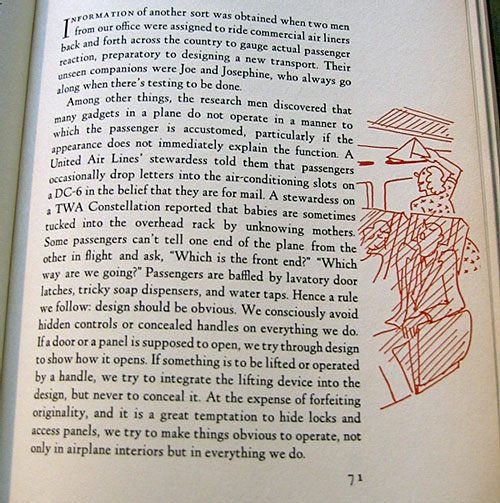January 29, 2004
Designing for People - Chapter 4: The Importance of Testing
This is the one chapter which will likely induce the most forehead-slapping for any practicing user-centered designer. Because it points out that, 'lo those many years ago, Henry Dreyfuss practiced a form of usability testing in order to understand how well his designs were performing. Those of us who have had to fight to get things tested will wonder how on earth such a situation can still exist, considering leading designers were testing half a century ago.
One of the crucial elements of Dreyfuss' testing is that, while rigorous in set-up, it was also informal in its practice. He didn't get hung up on some desire for scientific accuracy in his testing -- he just wanted to see people use his designs, understand what worked, what didn't, and be able to revise accordingly. It's something of a shame that the human factors world has so promoted a "right" way of doing usability that it has lead many people to feel that such testing can only be done by a Ph.D. In my experience, such folks often don't get the true value of testing in a design process, which is simply as a reality and sanity check, not as some attempt to capture 95% of all errors.
Dreyfuss recognizes that simply asking preferences from people can be misleading (hello, focus groups!), as they'll tell you what they think you want to hear. You've got to try to get them to *behave* as naturally as possible. He also highlights that other common pitfall -- the client claiming to do research, or to understand the customer, when, in fact, well, they don't.
Dreyfuss encourages as much _in situ_ observation as possible. That can be hard for us who work with computer interfaces -- there's not a lot of opportunity to watch people use them, and even when there is, say at a laptop-filled coffeehouse, folks aren't really appreciative of you staring over their shoulders. That said, I always find it fascinating to watch my parents at the machine, or my girlfriend as she surfs the Web. It reminds you just how different people can approach this similar box in different ways.
Dreyfuss details ambitious testing environments: a to-scale set of completely furnished rooms for an ocean liner, built in an old stable; or an interior mock-up or an airliner, complete with staff. In the latter they had "passengers" in the mockup for ten hours (the time of a transoceanic flight in those days).
The chapter ends with some amusing tales of perceived affordances in early airplane experiences:

I'll reiterate his final sentence:
At the expense of forfeiting originality, and it is a great temptation to hide locks and access panels, we try to make things obvious to operate, not only in airplane interiors, but in everything we do.
And he's talking about physical objects with inherently more obvious affordances! It still mystifies me, how many "designers" seek to obscure interactive elements to serve some aesthetic desire (and they often proclaim the value of "discovery" in the experience. Feh.)
